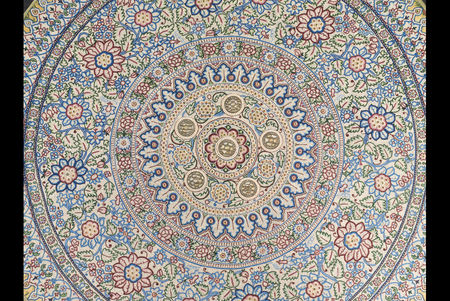Bejeweled Indian "Pearl Canopy of Baroda" to Be Auctioned at Sotheby's in New York
The Pearl Canopy of Baroda will go under the hammer on March 24 (detail). Photo: Sotheby's.
NEW YORK (REUTERS).- A stunning, rarely seen bejeweled, nearly 150-year-old canopy from India is expected to sell for as much as $5 million when it is auctioned next month, according to Sotheby's.
The Pearl Canopy of Baroda will go under the hammer on March 24 as part of a larger auction of Indian and Southeast Asian Works of Art in New York.
It includes over 500,000 pearls, as well as numerous diamonds, sapphires, rubies and emeralds sewn on silk. Floral "Persian-style" vines made with colored beads circle the canopy.
"The Maharaja was a great patron of the arts," said Mary Jo Otsea, the worldwide director of Sotheby's carpet department. "This piece is a continuation of the golden age of Indian art from the Mughal period, with Persian influences."
The canopy dates from around 1865, when it was commissioned by the Maharaja of Baroda, in the present-day Indian state of Gujarat. It is believed that the piece was intended to be donated as a gift to decorate the tomb of the Prophet Mohammed in Medina, in what is now Saudi Arabia.
The man who commissioned the canopy, Maharaja Khande Rao Gaekwar, was known to be particularly fond of jewels. In 1867, he bought the "Star of the South", one of the largest diamonds in the world.
The canopy is part of a set which included four large rectangular jewel-encrusted carpets, of which only one remains. One of the rectangular carpets was sold at an auction in Doha, Qatar in March 2009 for $5.4 million.
Art historians are still unsure exactly how the carpet and the canopy were arranged together, Otsea said.
"One possibility is this, that four pillars held the canopy over the carpet," Otsea explained. "Another is that it was somehow placed on a camel. But nobody knows, and the Maharajah died a long time ago."
The canopy had not been seen for more than 100 years until it was included in an exhibit at the Victoria and Albert Museum in London last year.
At the time the canopy was created the nominally sovereign state of Baroda was among the most prosperous in British India, with much of its income coming from cotton, rice and sugar.
Baroda state, which was founded in 1721, existed until it was incorporated into newly independent India in 1947.
"All the states of the time were under the Indian Raj. They were titular heads who led the people, and were free to appoint courts and commission workshops," Otsea said. "This Maharaja, from what I understand, got on very well with the British."
Otsea said the canopy is notable, even among the other luxurious works of art commissioned by regional rulers in Baroda and across British India.
"The Maharaja liked jewels, and it was very much a status symbol and showed wealth," she said. "But this is really something special." (Reporting by Bernd Debusmann Jr., editing by Patricia Reaney)
The Pearl Canopy of Baroda will go under the hammer on March 24. Photo: Sotheby's.

/https%3A%2F%2Fprofilepics.canalblog.com%2Fprofilepics%2F1%2F0%2F100183.jpg)




/http%3A%2F%2Fp9.storage.canalblog.com%2F92%2F51%2F119589%2F98216442.jpg)
/https%3A%2F%2Fassets.over-blog.com%2Ft%2Fcedistic%2Fcamera.png)
/https%3A%2F%2Fstorage.canalblog.com%2F77%2F60%2F577050%2F66527770_o.jpg)
/https%3A%2F%2Fstorage.canalblog.com%2F91%2F69%2F577050%2F66524735_o.jpg)